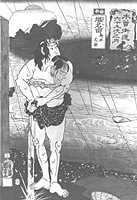

Tuesday brought with it the opening of a semester-long art exhibit at Allen Memorial Art Museum. Highlighting the unique woodblock prints of 19th-century Japanese artist Utagawa Kuniyoshi, the prints provide a lesson in history as well as an aesthetic appeal. Entitled ŌKuniyoshiÕs Kisokaido,Ķ the exhibit gives a glimpse into the world of Japanese history, mythology and ideals.
The prints themselves radiate bright, bold colors and are filled with extreme detail. Kuniyoshi left out no details in represtenting the stories of these prints, conveying all parts equally and skillfully and using a mix of sharp outline and soft, muted shapes. He manages to bring forth a depth of emotion ranging from comic to tragic, and in each of the print subjects, mystical elements were pervasive.

Each print has, either on its side or top, a cartouche written in Japanese that explains the story within it. Every piece is unique in content and often has a great amount of history behind it.
Coupled with the works of Kuniyoshi are the works of his predecessors Eisen and Hiroshige which flank the exhibit. These pieces, although not as lively in content or color as the works of Kuniyoshi, offer a simple glimpse into the Japanese culture, portraying people at work or in simple mountain scenes, all of which contain a type of quiet beauty which draws the onlooker into the print.
As for the history, KuniyoshiÕs Kisokaido series was one of his last as a printmaker; however, this series is probably his most popular of the thousands he created throughout his life. Commissioned in 1852, this series bears the name Kisokaido, but is not typical of the other Kisokaido/Tokaido works done during his time. At the time, print works depicting scenes of villages and people among the two major Japanese roads, the Tokaido and Kisokaido, were extremely popular. KuniyoshiÕs predecessors, Keisai Eisen and Utagawa Hiroshige did a much more subdued, simple and realistic version of the Kisokaido series in the 1930s.
Kuniyoshi decided against the common situations often depicted in other topographical prints. Instead, he based his prints on great Japanese warriors, tales of star-crossed lovers, supernatural deities and the stories that were the basis for the popular Kabuki plays of the period. Because these topics had little or nothing to do with situations that occurred upon the Kisokaido road, Kuniyoshi cleverly related his prints to the road by using verbal and visual puns, or by using scenes that supposedly occurred on the Kisokaido.
The 70 prints in the 71-set series of Utagawa Kuniyoshi are on display in the Allen Memorial Art MuseumÕs Ripin Print gallery until May 31.
Utagawa Kuniyoshi:: This print, Shionada: Torii Matasuke (1852), is one of many Kuniyoshis on display at AMAM. (photo courtesy of AMAM)
Copyright © 1998, The Oberlin Review.
Volume 127, Number 15, February 26, 1999
Contact us with your comments and suggestions.